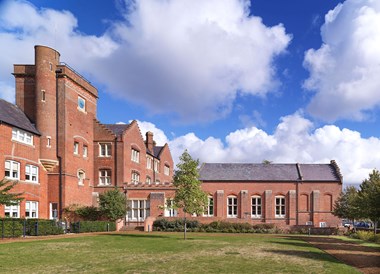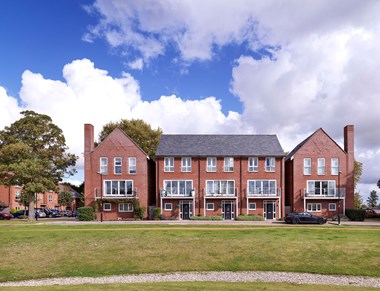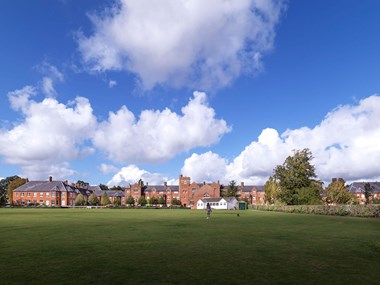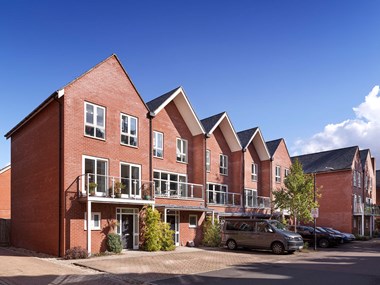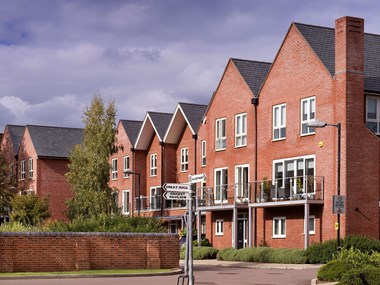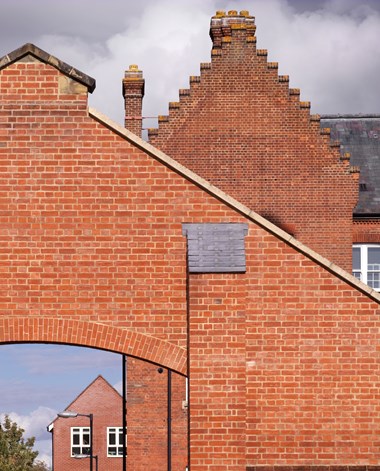Design Case Study, Fairmile Hospital, Cholsey, Oxfordshire
The re-development of a former hospital on the edge of a rural village with new homes designed as distinctive groups influenced by the historic buildings.
This case study is one of ten studies of new residential or mixed-use developments compiled in 2020 by Purcell on behalf of Historic England.
Project Information
- Region: South East
- Type of development: Former NHS hospital site
- Location and postcode: Cholsey, South Oxfordshire, OX10 9HH
- Local planning authority: South Oxfordshire District Council
- Architects: JTP Architects and Woodfield Brady Architects
- Developer/land owner: Linden Homes, Thomas Homes, Homes & Communities Agency
- Number of of residential units: 220 new-builds plus 95 within converted buildings
- Site area: 27 hectares
- Other uses: Community facilities – sports’ pitches, allotments, play area, multi-use hall
Description of development
The scheme at Fairmile sought to re-develop the former hospital site into a new mixed-use community with a variety of different homes. The 19th-century buildings were converted into residential units and community facilities, with new-build clusters across the site following the demolition of lower-quality and modern hospital buildings. Allotments and sports’ pitches were established within the surrounding landscape. To incorporate the new community and its facilities with the surrounding area, provision was also made for an enhanced bus service.
Heritage assets affected
The original hospital was built 1868-70 to the designs of C H Hine, and later extended at several periods. The main hospital building, former chapel and entrance lodge are all individually listed at Grade II. The surrounding parkland landscape – comprising pleasure grounds, airing courts, walled gardens and woodland extending down to the River Thames – is designated as a Grade II Registered Park and Garden.
Planning context
The South Oxfordshire Local Plan 2011 (adopted in 2006) included a policy specifically for the future re-development of the former hospital site. The Cholsey Plan was produced following consultation with the local community in 2006, setting out their aspirations. A development brief was also prepared by South Oxfordshire District Council in 2003. One of its recommendations was the preparation of a conservation plan, which was ultimately endorsed by the Council and given material weight in the decision-making process.
Assessment of design qualities and relationship to historic environment
The preparation of a site-wide conservation plan and gazetteer identified three groups of building on the hospital site:
- the original 1870s structures (listed and curtilage);
- curtilage-listed structures added between the original construction phase and 1948; and
- post-1948 structures with little or no merit, or which detract from the site.
Demolition was concentrated to the north-east and south-west of the site, where later development had little relationship with the 1870s hospital buildings, and detracting infill development around the core of the main building. This freed up defined areas around the edge of the site for new development; this ensured that the historic landscape on the north and south sides of the main hospital remained largely unbroken and any new development was respectful of its local landscape context.
At the north-west corner of the site, closest to the village, the new buildings were more densely configured in a more urban arrangement of terraces. Beyond this, along the thickly planted west perimeter road, development was more rural in character with weatherboarding and cottage/agricultural building typologies.
On the south and immediate east sides of the main hospital building, the new development was more formally arranged as flanking townhouses responding to the orientation of the listed building’s south elevation and views outwards. As with the west side, development along the eastern edge is more rural in character with country mews-style homes tucked behind the townhouses and a detached group of slightly larger houses.
The varied development densities and building typologies create an evolving sense of character moving through the site. The prominent use of red brick and architectural detailing using this material ties the new buildings back to the original 1870s structures.
On the more modest mews and cottage houses, the use of hung clay tiles is also illustrative of local building traditions. The positioning of chimneystacks and the angle of gable pitches have also drawn influence from the existing buildings to avoid stark contrasts between old and new.
On the north side of the site, the group value and configuration of the former hospital’s principal elevation set back behind a formal lawn and flanked by a farm and the chapel is protected as part of the masterplan. The rural streetscape has been continued around the west and east sides of the site with the new development, which has been configured to permit views outwards towards the surrounding countryside. In further recognition of the importance of the landscape, features including balconies and principal elevations have been articulated to take in views across the green spaces. The positioning of chimneystacks and the angle of gable pitches have also drawn influence from the existing buildings to avoid stark contrasts between old and new.
Key points
The unsuitability of the site to effectively function as a hospital in the 21st century was recognised in 2003 when NHS services ceased to operate at Fairmile. Following this, the need to establish a new use was instigated by the transfer of 96 former hospital sites from the NHS in 2005 to The Homes and Communities Agency (now Homes England), whose key aims were to protect the heritage assets, efficiently re-use the buildings, and to deliver homes, including affordable homes. Although historic buildings should ideally not be left vacant for extended periods, the five years between transfer and planning permission was well invested in assessing the capacity of the site and the expectations of the local community.
The preparation of a conservation plan and gazetteer to inform the master plan ensured that the varying significance of the buildings across the site was understood and the resulting demolitions and pockets of new development could be justified. This exercise also highlighted opportunities to enhance the listed buildings; such as the removal of later infill extensions and a revived use for the former chapel. Endorsement by the local planning authority also adds weight to the proposals.
Consultation with the local community played a particularly important role in striking the right balance of residential development and public amenity.
Views of Fairmile Hospital Redevelopment
Please click on the gallery images to enlarge.
Design in the historic environment: more case studies
-
Design in the Historic Environment
Principles and case studies for good practice in design when making changes to the built historic environment.
-
Design in the Historic Environment: Case Studies
Download all ten case studies as a PDF document.
-
Design Case Study: Roussillon Park Chichester, West Sussex
A case study of design in the historic environment: Roussillion Park is a modern residential complex at the site of a former barracks in Chichester.
-
Wildernesse House Mews, Sevenoaks
Case study of a new mews-style development within the setting of a Grade II listed mansion and within an area of historic landscape.
-
Bourne Estate, Holborn, London
An award-winning residential extension on a Grade II listed urban estate, bringing together old and new through quality detailing and landscaping.
-
Design Case Study: 168 Upper Street, Islington
A case study of an imaginative reinstatement of a missing corner building in Islington that reproduces the original facade.
-
Temple Gardens, Temple Cloud
Design case study of the refurbishment and viable reuse of a listed pub, with a sensitive scheme of new housing and hotel development.
-
Garden Quarter, Caversfield
Case study for design in the historic environment of the sensitive redevelopment of a former Royal Air force site into a residential community.
-
Church Fields, Boston Spa
A design case study featuring a residential extension to the edge of an historic village that interprets traditional architectural forms.
-
Timekeepers Square, Salford
Case study of a redevelopment that recreates the vernacular Georgian terrace and urban grain within the setting of a listed church.
-
Welsh Streets Liverpool 8
Case study of an ambitious and popular scheme that converts hundreds of derelict Victorian terraced houses.


